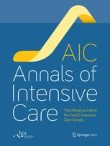Citation Impact 2023
Journal Impact Factor: 5.7
5-year Journal Impact Factor: 6.0
Source Normalized Impact per Paper (SNIP): 1.749
SCImago Journal Rank (SJR): 2.061
Speed 2023
Submission to first editorial decision (median days): 7
Submission to acceptance (median days): 91
Usage 2023
Downloads: 1,737,465
Altmetric mentions: 6,851
Clinical Warburg effect in lymphoma patients admitted to intensive care unit
The Warburg effect, characterized by elevated lactate levels without tissue hypoxia or shock, has been described in patients with aggressive lymphoproliferative malignancies. However, the clinical characterist...








